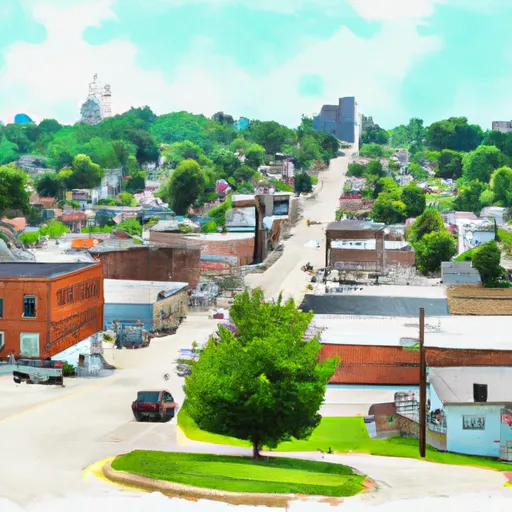-
 Snoflo Premium
Snoflo Premium
Get unlimited access to all our content
With no Ad interruptions! - Start Your Free Trial Login with existing account
Keaton
Eden Index
Climate
8.3
•
Recreation
2.0
•
Community
•
Safeguard
4.0/10

Keaton, Kentucky is a small town nestled in the heart of Boyd County. This charming community is known for its diverse climate, hydrology constituents, and abundant outdoor recreation opportunities. Located in the Appalachian region, Keaton experiences all four seasons, with mild springs, warm summers, colorful autumns, and brisk winters.
The climate of Keaton is influenced by its proximity to the Ohio River, which borders the town. This brings about a moderate climate, with average temperatures ranging from the 40s°F in winter to the 80s°F in summer. The area receives an average annual rainfall of around 45 inches, ensuring lush greenery and vibrant flora.
Hydrology constituents in Keaton are abundant, thanks to the nearby Ohio River and various creeks that flow through the region. These water bodies provide recreational opportunities such as fishing, boating, and kayaking. The Ohio River is known for its excellent fishing, with plentiful catfish, bass, and panfish.
Outdoor enthusiasts will find plenty of recreation opportunities in Keaton. The area is surrounded by a stunning natural landscape, perfect for hiking, camping, and wildlife observation. The nearby Yatesville Lake State Park offers a picturesque retreat with opportunities for boating, swimming, and picnicking.
In conclusion, Keaton, Kentucky offers a diverse climate, abundant hydrology constituents, and a wide array of outdoor recreational opportunities. Whether exploring the natural beauty, enjoying water activities, or immersing in the changing seasons, Keaton is a haven for nature lovers and adventure seekers.
What is the Eden Index?
The Snoflo Eden Index serves as a comprehensive rating system for regions, evaluating their desirability through a holistic assessment of climate health, outdoor recreation opportunities, and natural disaster risk, acknowledging the profound impact of these factors on livability and well-being.
Climate Health Indicator (CHI): 8.3
Keaton receives approximately
1144mm of rain per year,
with humidity levels near 83%
and air temperatures averaging around
13°C.
Keaton has a plant hardyness factor of
6, meaning
plants and agriculture in this region thrive during a short period during spring and early summer. Most
plants will die off during the colder winter months.
By considering the ideal temperature range, reliable water supplies, clean air, and stable seasonal rain or snowpacks, the Climate Health Indicator (CHI) underscores the significance of a healthy climate as the foundation for quality living.
A healthy climate is paramount for ensuring a high quality of life and livability in a region, fostering both physical well-being and environmental harmony. This can be characterized by ideal temperatures, reliable access to water supplies, clean air, and consistent seasonal rain or snowpacks.
Weather Forecast
Streamflow Conditions
Big Sandy
Area Rivers
Big Sandy
Snowpack Depths
Big Sandy
Reservoir Storage Capacity
Big Sandy
Groundwater Levels
Recreational Opportunity Index (ROI): 2.0
The Recreational Opportunity Index (ROI) recognizes the value of outdoor recreational options, such as parks, hiking trails, camping sites, and fishing spots, while acknowledging that climate plays a pivotal role in ensuring the comfort and consistency of these experiences.
Access to outdoor recreational opportunities, encompassing activities such as parks, hiking, camping, and fishing, is crucial for overall well-being, and the climate plays a pivotal role in enabling and enhancing these experiences, ensuring that individuals can engage in nature-based activities comfortably and consistently.
Camping Areas
| Campground | Campsites | Reservations | Toilets | Showers | Elevation |
|---|---|---|---|---|---|
| Portal 31 RV Park | 20 | 1,841 ft | |||
| Jenny Wiley State Park | 115 | 857 ft | |||
| Carr Creek State Park | 40 | 1,093 ft | |||
| Littcarr - Carr Creek Lake | None | 1,050 ft | |||
| Natural Tunnel State Park | None | 1,703 ft | |||
| Paintsville Lake State Park | 40 | 618 ft |
Nearby Ski Areas
Catastrophe Safeguard Index (CSI):
The Catastrophe Safeguard Index (CSI) recognizes that natural disaster risk, encompassing floods, fires, hurricanes, and tornadoes, can drastically affect safety and the overall appeal of an area.
The level of natural disaster risk in a region significantly affects safety and the overall livability, with climate change amplifying these risks by potentially increasing the frequency and intensity of events like floods, fires, hurricanes, and tornadoes, thereby posing substantial challenges to community resilience and well-being.
Community Resilience Indicator (CRI):
The Community Resilience Indicator (CRI) recognizes that education, healthcare, and socioeconomics are crucial to the well-being of a region. The CRI acknowledges the profound impact of these elements on residents' overall quality of life. By evaluating educational resources, healthcare accessibility, and economic inclusivity, the index captures the essential aspects that contribute to a thriving community, fostering resident satisfaction, equity, and social cohesion.

